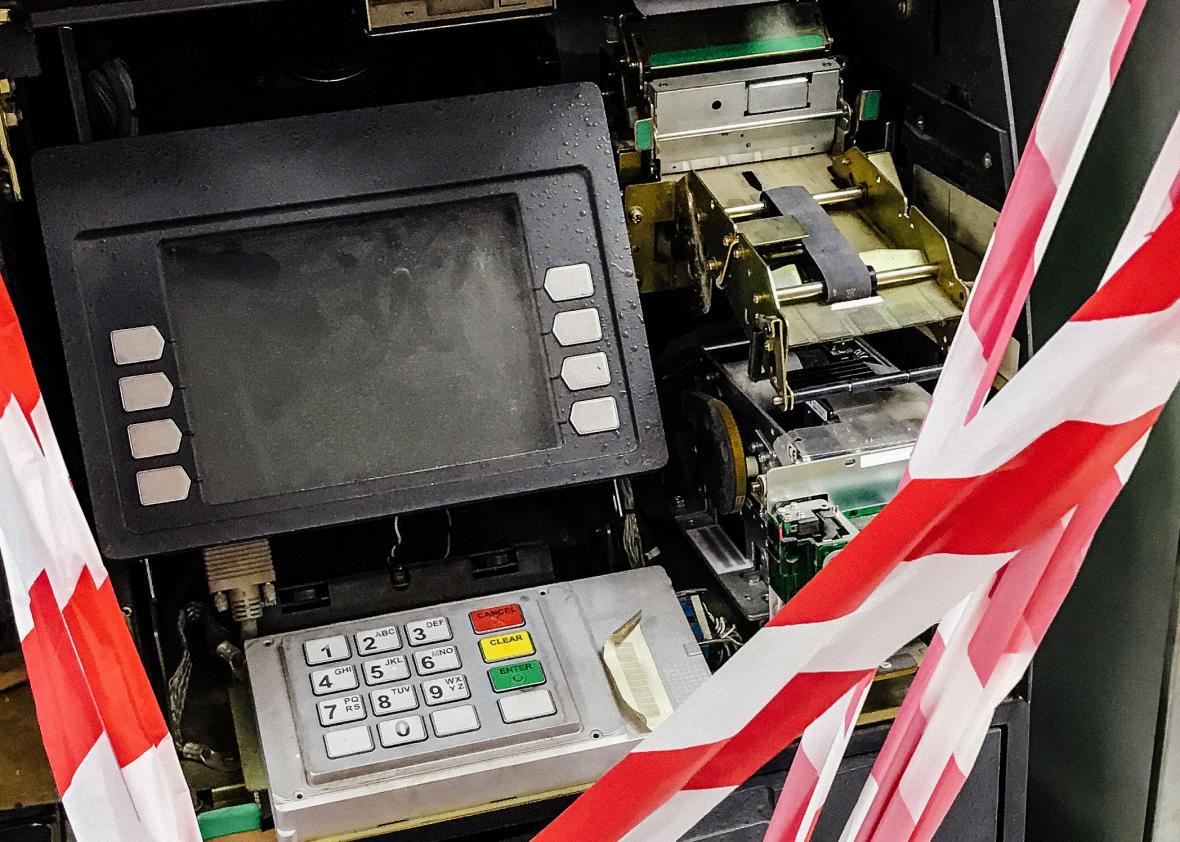Don’t look now, but banks are failing again in America.
The past several years have been relatively placid for the banking industry. After the wholesale failure of the system during the financial crisis, banks gradually recovered their footing. Aided by essentially free money from the Federal Reserve, bailouts, and widespread federal and central bank guarantees, banks once again became rock-solid American institutions. As the expansion rolled on, companies and individuals did a much better job keeping up with their financial obligations. The result: record profits for banks and an extremely low rate of bank failure.
In 2016, banks covered by the Federal Deposit Insurance Corporation reported $171.3 billion in profits. Only five banks failed last year—“the smallest number of bank failures in a year since three FDIC-insured institutions failed in 2007,” the FDIC noted. What’s more, the banks that failed were truly marginal, counting just 18 branches and a mere $277 million in assets between them. In 2015, seven banks in the continental U.S. failed; they had combined assets of $826 million.
But something worrisome is happening in 2017. So far this year, five banks have already failed—as many as in all of 2016. More important, the banks that are failing are significantly larger. Last week, Guaranty Bank of Milwaukee ($1 billion in assets and 118 branches) bit the dust. The week before, it was First NBC Bank of New Orleans ($4.7 billion in assets and 29 branches).
What gives? We can’t blame this one on Donald Trump, for starters. Instead, it has everything to do with where we are in the economic cycle and the fact that credit businesses like banking are remarkably procyclical. That is to say: Financial success begets financial success throughout the system—which is what generally happened between 2011 and 2016. But there’s a flipside to this equation, which is easy to forget during the good times: Financial failure begets financial failure. For the first time in nearly a decade, this is what we are starting to see.
The U.S. economy is, by most accounts, rolling along. The current expansion is now in its 95th month. The economy has added payroll jobs for a record 79 months, and the unemployment rate is at 4.4 percent.
When expansions get longer, a few things happen. Banks, consumers, and companies all get more confident about their ability to handle debt, which leads to more credit being extended. At the same time, lenders seeking growth start to become more aggressive about putting money in the hands of people. Once all the people who can easily afford to purchase cars have taken car loans or mortgages, banks must seek out more marginal borrowers in order to keep boosting their profits. And once credit gets distributed a little too widely, borrowers begin to default—even if nothing else changes in the economy or the climate for credit.
But something is changing. For the first time in a decade, the Federal Reserve is raising interest rates—thus increasing the cost of borrowing and servicing debt. Before December 2015, when the Fed boosted the federal funds rate from zero to 0.25 percent, it had been 9.5 years since the Fed last raised the interest rates it controls. Janet Yellen has since raised rates in 0.25 percent increments twice. Yes, interest rates are still remarkably low, and the moves have been small. But it’s the direction that matters. For a decade, people in the economy had been conditioned to think that interest rates don’t really go up—and they borrowed and planned accordingly.
When interest rates were low and generally declining, people could refinance their way out of trouble. But when interest rates go up, it becomes harder to avoid trouble. And so as rates rise this deep in an economic cycle, it’s not surprising that the rate of financial failures is increasing. After hitting the lowest level since 2006 in the third quarter of 2016, mortgage delinquency rates rose in the fourth quarter to 4.8 percent. The delinquency rate on credit card loans, while still at a very low level, rose for three straight quarters in 2016. The volume of auto loans that are delinquent is rising rapidly. All these metrics will likely continue to rise.
In addition, it’s worth recalling that this recovery has been remarkably uneven. Amid the long expansions we enjoy, there are always pockets (large and small) of distress. So if you’ve extended credit aggressively in an area that is struggling to begin with, and interest rates start to rise, you’re likely to run into trouble quickly. Guaranty Bank, which failed in early May, lends primarily to lower- and middle-income people in urban areas, a demographic slice that hasn’t fully participated in the expansion. New Orleans’ First NBC Bank, the biggest failure so far this year, is a relatively new bank (founded 2006) that lent heavily to the oil and gas industry, which has been traumatized by persistently low prices.
None of this is to say we’re going to have a repeat of the financial crisis. And we’re not in any danger of a recession. But the spate of failures should set off alarms. The forces that have helped turn the direction of delinquency rates around are still very much with us. The business cycle continues to age, Yellen has telegraphed her intention to jack up rates further, and there are still plenty of people and companies struggling in this economy. What’s more, a sudden increase in financial failures tends to push banks and other lenders to pull back credit and tighten lending terms—which means it will be harder for people to refinance their way out of trouble or ask for leniency. There’s a lot more failure where these failures came from.
